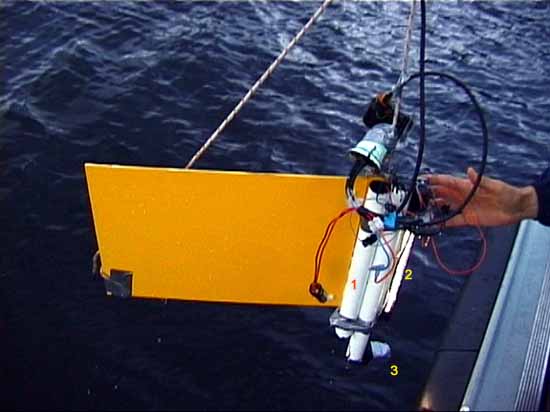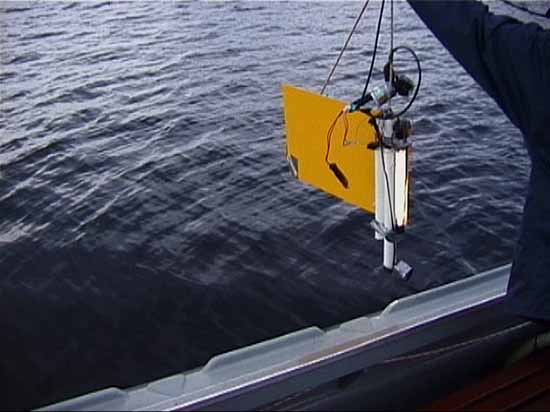24th September 2000
After many days of bad weather an opportunity arose on the evening of Sunday 24th September 2000 to test a number of components of any future deep camera system. These are the "building blocks" which allow a specialised camera unit to be quickly assembled in an hour or two.
Power supply.
From the start it was obvious
that the cost of multi-conductor cable was a major negative factor in low-budget
research experiments like the ones I engage in. Put simply, I couldn't
afford to buy any. The resistance losses incurred in trying to send even
a few amperes through 1000 feet (300 metres) of cable are considerable,
and can only be overcome by using thicker cable ( which is too heavy to
haul by hand) or higher voltages, which can be bad for your tooth fillings.
The obvious path to be explored was to send the battery down with the equipment
it was to power. That way, only a video signal is sent from the bottom
to the surface, and a single co-axial cable can be used.
Experiments with a pack of Nickel-Cadmium batteries encased in putty-like material had shown that they could survive immersion in fresh-water to 230 metres (see "Camera goes to 234 metres!-July 2000), and so a more permanent and hydrodynamically acceptable arrangement was devised. Similar Ni-Cad cells were placed in sealed pvc tubes with their cable emerging through the resin seal at one end. Two packs were made, with 5 cells in each, providing 6 volts and 4 Amp-hours of nominal capacity, or 12 volts if connected in series.

Copyright 2000 Dick Raynor
Side view of test rig used on 24th September 2000. (1) White tubes contain Ni-Cad cells, (2) is fluorescent lamp, and (3) is the tv camera, with tape holding a supplementary close-up lens in place. And the tangle of wires? That is a patent plesiosaur bone collector.

Copyright 2000 Dick Raynor
Lights
As the previous dive to 230
metres had successfully tested a naked halogen lamp, I constructed a much
more energy efficient fluorescent tube encased in some "Perspex" tubing
that I had originally purchased in 1975 to build my first sonar-triggered
underwater camera. ( No, it is not in the literature - it didn't work!)
The lamp is switched on by placing a magnet on the outside of the tubing,
which activates an internal reed switch to complete the circuit.
A secondary lamp unit was made consisting of an automobile fog-lamp bulb like the one tested in July. Instead of being open to the elements, it was encased in a glass test-tube and sealed with epoxy resin. This was to be simply pressure tested by lowering to the bottom attached to the main rig.
Cable
On the earlier dive the television
co-axial cable had shown that it had a few leaks, and these had been taped
over with self-amalgamating tape.
Camera
As I have already used System
Q Advanced Vision cameras to about 100 metres without modification, and
to 230 metres with some "beefing up" (your mileage may vary),
I decided to see at what depth the "standard issue" camera would be destroyed.
To do this, I simply connected up a spare camera to the bottom of the rig,
leaving the earlier camera still on the cable.
Brief Results
Power Supply: Success! It was with some relief that we continued to receive a video signal throughout the dive. On recovery a small section of one battery tube was found to be partially collapsed, probably due to lack of resin inside it, but the unit was still working.
Lights: Success!While not being positioned correctly to give good illumination of the bottom, the fluorescent lamp assembly survived the test. In future devices, at least 2 tubes are envisaged, with the camera slung between them.
Cable: Success! Taped over leaks stayed waterproof, one new leak found after the dive.
Camera: Failure! Despite lowering the camera (modestly described as "waterproof") to an indicated 230 metres it continued to work magnificently - I failed to break it!
I don't think you can get these cameras in the shops...if you want to buy one, email me!
This experiment was carried out by Dick Raynor and Adrian Shine from
the Loch Ness Project research vessel "M.V.Deepscan" on 24th September
2000.